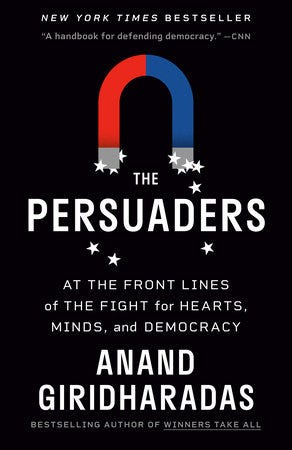SUMMER READING: The inside-outside game, part two
Calling in and calling out with Alexandria Ocasio-Cortez
What does an outsider do once they’re on the inside?
Yesterday, we talked about how Representative Alexandria Ocasio-Cortez developed the beliefs that built her political identity: how she learned to navigate multiple worlds, how she came to understand how to advocate for herself and for others, and how Bernie Sanders’ 2016 campaign helped her put the pieces together that let her recognize what she could be — and do.
Today’s excerpt from Anand’s 2023 book The Persuaders: At the Front Lines of the Fight for Hearts, Minds, and Democracy explores what she calls her “crucible” — the period after college when she worked with National Hispanic Institute founder Ernesto Nieto and got the mentorship and training that made her an activist, and when she learned the persuasive skills that would turn her beliefs into a political force.
If you’ve been looking to understand the real story behind how Ocasio-Cortez went from waitress to Congresswoman, and how she has been able to skillfully combine a “politics of accommodation and a politics of confrontation,” we invite you to read on.
For our supporting subscribers, we are presenting this profile of Alexandria Ocasio-Cortez in installments this week. For the first part of the chapter, click on the link below; read on for the second part, and stay tuned this week for the rest of the story.
The inside-outside game, continued
“Make me proud,” her father had said. And for a time after his death, the obvious fulfillment of Sergio’s wish was for Alexandria to succeed in college. But with college behind her, the crisis that had resulted from Sergio’s death rose to the fore. Blanca was sinking in debt. Her daughter returned to the Bronx to help even as she got on her own feet. In the abridged and oft-repeated narrative of Ocasio-Cortez’s life, what happened next is some waitressing followed by the parlaying of waitressing into a seat in Congress. What this narrative skips over is Ocasio-Cortez’s early career in the Bronx, a period in which she encountered and trained herself in some of the ideas and methods that would gird her subsequent life in politics.
Straight out of college, she took a job with an organization called the National Hispanic Institute, run by a charismatic founder named Ernesto Nieto who would leave a profound imprint on her. She had first become connected to the organization in high school, attending a conference that drew students from across the country. “That’s when I was like, ‘Holy shit. I’m Latina. Like, Oh, wow, there’s actual other people like me,’” she told me. “It wasn’t until I met other people from across the country that were like me and I was like, ‘Oh, there are other people like me.’ That changed my narrative in my life.” She kept coming back to the organization, volunteering with the NHI during college at its high schoolers’ conventions, then taking a full-time job with the NHI after Boston University.
The NHI was animated by a particular philosophy that Nieto has called the “third reality,” a path between what he saw as the road of protesting the white establishment and the road of seeking to engage with it at the risk of assimilation. “Should we surrender to the omnipresence of mainstream culture and merely attempt to fit in, whatever the costs to our identity as community and culture? Should we continue the fight for social justice and reform? Or is there a third choice, a third reality?” Nieto writes in his book titled Third Reality. That third reality, in Nieto’s view, broke both from the cultural erasure of the melting pot and from the endless waiting of fighting the Anglo power establishment. Instead, it focused on helping the community see itself in new ways. “A third reality was needed, one that would lead our young to shape a different Latino community. They no longer needed to spend time reacting to issues outside their control. Efforts had to concentrate on reshaping and recreating a different self-identity and belief, one that enthused youth about their future in the Latino community.” But Nieto wasn’t interested in identity for its own sake. Rather, he spoke of how the development and sharing of self-knowledge could aid the pursuit of system change—how, as Sanders would later grapple with, the personal could aid the structural.






